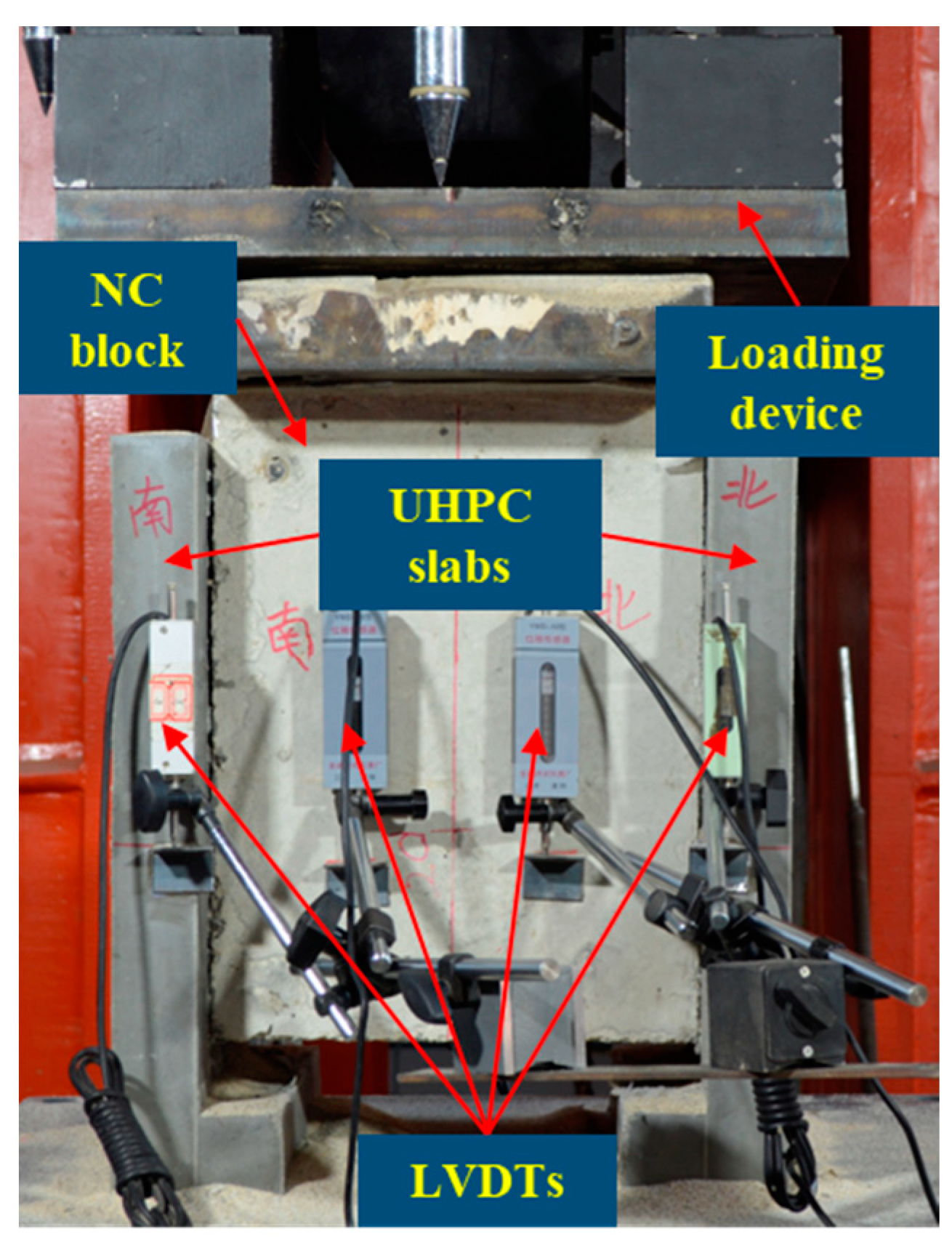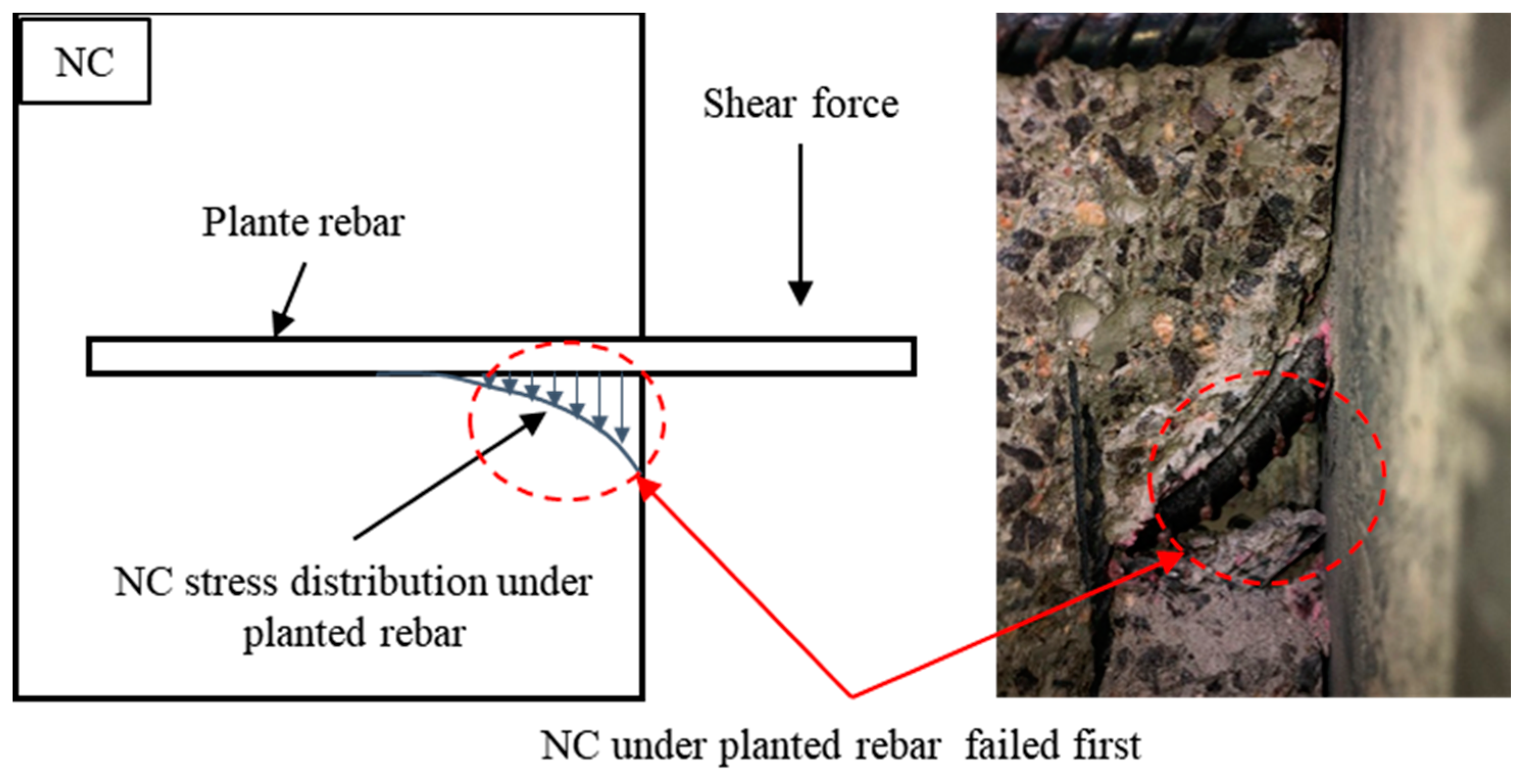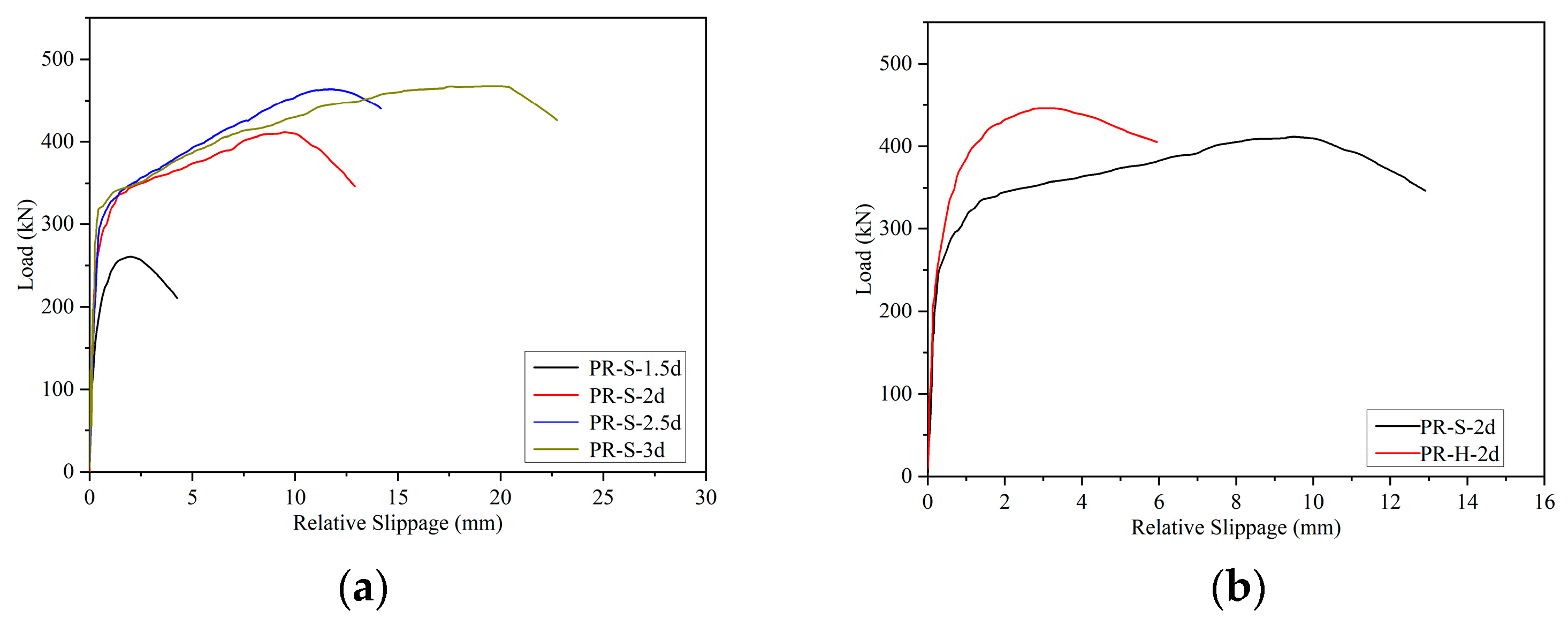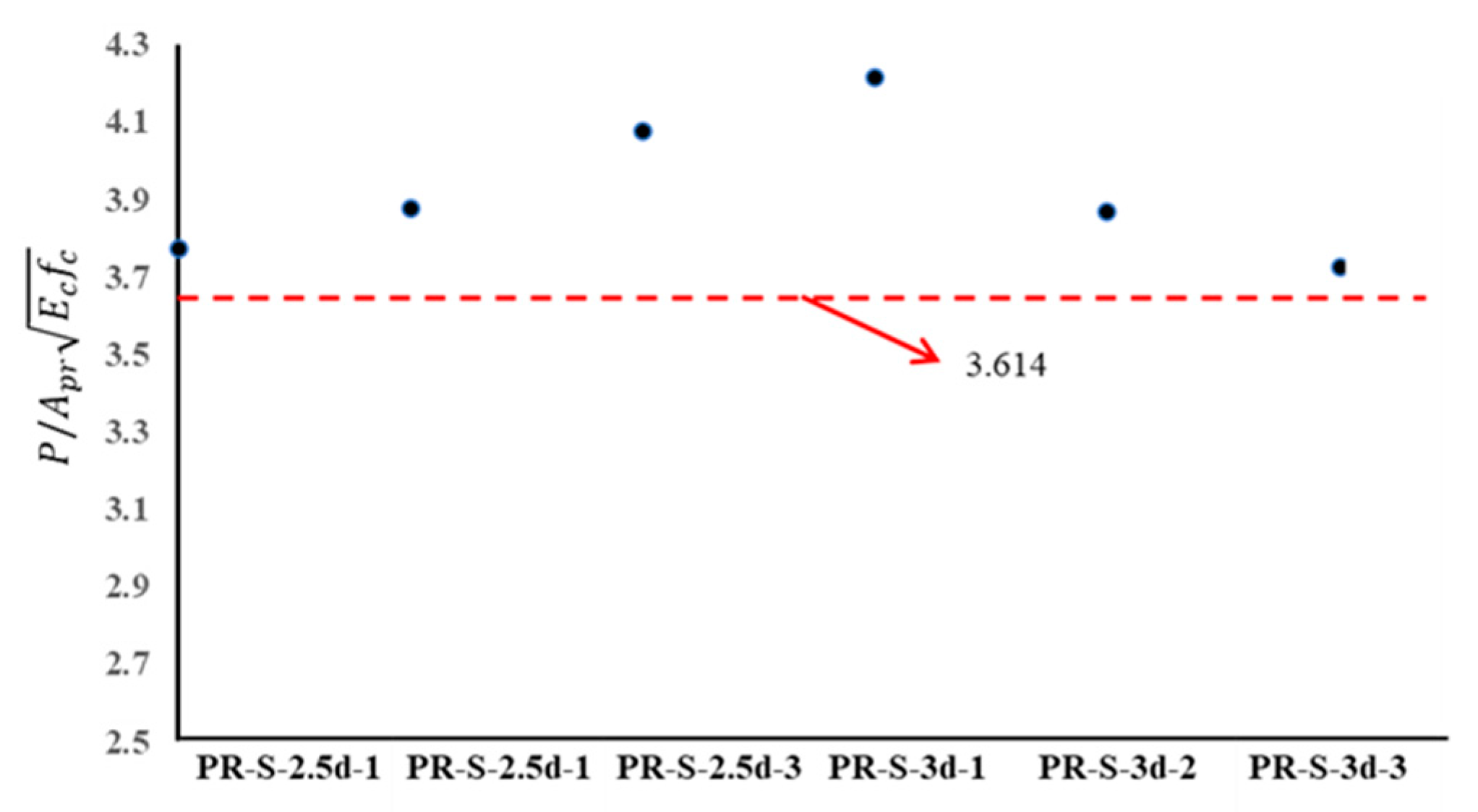Experimental Investigation on Interface Performance of UHPC-Strengthened NC Structure through Push-Out Tests
Abstract
:1. Introduction
2. Materials and Methods
2.1. Design of Specimen
2.2. Material Properties
2.3. Test Setup and Procedure
3. Results and Discussion
3.1. Failure Mode
3.2. Load-Slip Curves
3.3. UHPC–NC Interface Shear Strength and Stiffness
3.3.1. UHPC–NC Interface Shear Strength
3.3.2. UHPC–NC Interface Shear Stiffness
4. Design Recommendation
5. Conclusions
- (1)
- The failure mode of the UHPC–NC interface is related to the interface preparation method used, which is specifically divided into interface failure, planted rebar pull-out and NC shear failure. The critical aspect ratio for the pull-out and anchorage of planted rebars in UHPC is around 2. When the aspect ratio of planted rebars is greater than or equal to 2.5, the complete anchorage of planted rebars in UHPC can be guaranteed. The ultra-high compressive and tensile properties of UHPC greatly reduce the length of fully anchored rebars in UHPC, which can greatly reduce the thickness of UHPC-strengthened layers.
- (2)
- When the planted rebar in UHPC is fully anchored, as the weakest part among the UHPC, NC, and planted rebar, the NC at the lower edge of the planted rebar is the first to be crushed under shear force, which means that the strength of NC needs to be considered when determining the shear capacity of a planted rebar.
- (3)
- The UHPC–NC interface load-slip curve can be divided into three sections: the linear section, yield section, and drop section. The shear-bearing capacity of the interface in the linear section is mainly sustained by the bond strength of UHPC and NC. The shear bearing capacity is jointly sustained by the planted rebars and the interface friction is caused by the lateral constraints of the planted rebars on UHPC and NC, while the planted rebars are pulled out or NC failure occurs in the descending section.
- (4)
- The interface shear strength of the straight planted rebar interface preparation method is significantly improved compared with that of the chiseling and smoothing methods, and as the embedding length of the planted rebar becomes longer, it first increases greatly and then tends to be stable when the planted rebar in the UHPC is fully anchored. The shear stiffness of UHPC–NC increases with the increase of the planted rebar’s aspect ratio.
- (5)
- The shear strength and shear stiffness of the UHPC–NC interface can be significantly improved by using the preparation method of planting a hooked rebar, but its ductility will be reduced.
- (6)
- A formula has been provided to calculate the ultimate shear strength of the interface between the UHPC layer and the concrete structure for the design of UHPC-strengthened concrete structures.
Author Contributions
Funding
Institutional Review Board Statement
Informed Consent Statement
Data Availability Statement
Conflicts of Interest
References
- Anas, S.M.; Alam, M.; Umair, M. Experimental and numerical investigations on performance of reinforced concrete slabs under explosive-induced air-blast loading: A state-of-the-art review. Structures 2021, 31, 428–461. [Google Scholar] [CrossRef]
- Anas, S.M.; Alam, M.; Shariq, M. Damage response of conventionally reinforced two-way spanning concrete slab under eccentric impacting drop weight loading. Def. Technol. 2023, 19, 12–34. [Google Scholar] [CrossRef]
- Anas, S.M.; Alam, M.; Umair, M. Performance of (1) concrete-filled double-skin steel tube with and without core concrete, and (2) concrete-filled steel tubular axially loaded composite columns under close-in blast. Int. J. Prot. Struct. 2022. [Google Scholar] [CrossRef]
- Hassan, A.; Elkady, H.; Shaaban, I.G. Effect of Adding Carbon Nanotubes on Corrosion Rates and Steel-Concrete Bond. Sci. Rep. 2019, 9, 6285. [Google Scholar] [CrossRef] [Green Version]
- Said, M.; Abd El-Azim, A.A.; Ali, M.M.; El-Ghazaly, H.; Shaaban, I. Effect of elevated temperature on axially and eccentrically loaded columns containing Polyvinyl Alcohol (PVA) fibers. Eng. Struct. 2020, 204, 110065. [Google Scholar] [CrossRef]
- Ueda, H.; Tamai, Y.; Kudo, T. Evaluation of the Durability of Cement-based Repair Materials. Q. Rep. RTRI 2011, 52, 92–96. [Google Scholar] [CrossRef]
- Shafieifar, M.; Farzad, M.; Azizinamini, A. Experimental and numerical study on mechanical properties of Ultra High Performance Concrete (UHPC). Constr. Build. Mater. 2017, 156, 402–411. [Google Scholar] [CrossRef]
- Valikhani, A.; Jahromi, A.J.; Mantawy, I.M.; Azizinamini, A. Experimental evaluation of concrete-to-UHPC bond strength with correlation to surface roughness for repair application. Constr. Build. Mater. 2020, 238, 117753. [Google Scholar] [CrossRef]
- Tayeh, B.A.; Bakar, B.H.A.; Johari, M.A.M.; Voo, Y.L. Evaluation of Bond Strength between Normal Concrete Substrate and Ultra High Performance Fiber Concrete as a Repair Material. Procedia Eng. 2013, 54, 554–563. [Google Scholar] [CrossRef] [Green Version]
- Wang, B.; Li, Q.; Liu, F.; Xu, S.; Zhou, H.; Tan, K. Comparison of Cast-In-Situ and Prefabricated UHTCC Repair Systems under Bending. J. Mater. Civ. Eng. 2018, 30, 04017249. [Google Scholar] [CrossRef]
- Zhang, Y.; Zhu, P.; Liao, Z.; Wang, L. Interfacial bond properties between normal strength concrete substrate and ultra-high performance concrete as a repair material. Constr. Build. Mater. 2020, 235, 117431. [Google Scholar] [CrossRef]
- Zhang, Y.; Wang, X. Experimental Study on Shear Behavior of RC Structure Interface Strengthened by UHPC. J. China Foreign Highw. 2017, 37, 105–111. [Google Scholar]
- Tayeh, B.A.; Abu Bakar, B.H.; Megat Johari, M.A.; Voo, Y.L. Mechanical and permeability properties of the interface between normal concrete substrate and ultra high performance fiber concrete overlay. Constr. Build. Mater. 2012, 36, 538–548. [Google Scholar] [CrossRef]
- Tayeh, B.A.; Abu Bakar, B.H.; Megat Johari, M.A. Characterization of the interfacial bond between old concrete substrate and ultra high performance fiber concrete repair composite. Mater. Struct. 2012, 46, 743–753. [Google Scholar] [CrossRef]
- Harris, D.K.; Carbonell Muñoz, M.A.; Gheitasi, A.; Ahlborn, T.M.; Rush, S.V. The Challenges Related to Interface Bond Characterization of Ultra-High-Performance Concrete With Implications for Bridge Rehabilitation Practices. Adv. Civ. Eng. Mater. 2014, 4, 75–101. [Google Scholar] [CrossRef]
- Kang, S.-H.; Hong, S.-G. Effect of Surface Preparation and Curing Condition on the Interfacial Bond Strength between Ultra High Performance Concrete and Normal Strength Concrete. J. Korea Inst. Struct. Maint. Insp. 2015, 19, 149–160. [Google Scholar]
- Tayeh, B.A.; Bakar, B.H.A.; Megat Johari, M.A.; Zeyad, A.M. Flexural Strength Behavior of Composite UHPFC-Existing Concrete. Adv. Mater. Res. 2013, 701, 32–36. [Google Scholar] [CrossRef]
- Roy, M.; Ray, I.; Davalos, J.F. High-Performance Fiber-Reinforced Concrete: Development and Evaluation as a Repairing Material. J. Mater. Civ. Eng. 2014, 26, 04014074. [Google Scholar] [CrossRef]
- Wang, X. Research on the Interfacial Shear Behavior of UHPC and Reinforced Concrete. Ph.D. Thesis, Hunan University, Changsha, China, 2016. [Google Scholar]
- Jang, H.-O.; Lee, H.-S.; Cho, K.; Kim, J. Experimental study on shear performance of plain construction joints integrated with ultra-high performance concrete (UHPC). Constr. Build. Mater. 2017, 152, 16–23. [Google Scholar] [CrossRef]
- Wang, J.-Y.; Guo, J.-Y.; Jia, L.-J.; Chen, S.-M.; Dong, Y. Push-out tests of demountable headed stud shear connectors in steel-UHPC composite structures. Compos. Struct. 2017, 170, 69–79. [Google Scholar] [CrossRef]
- Zhang, Y.; Wu, J.; Shao, X.; Hou, C. Experiment on interfacial shear properties between ultra-high performance concrete and normal strength concrete. China Civ. Eng. J. 2021, 54, 81–89. [Google Scholar]
- Ye, G. Study on The Anti-shear Behavior of Bond-Interface Between New and Old Concrete. Master’s Thesis, Chongqing University, Chongqing, China, 2011. [Google Scholar]
- GB 50367-2013; Code for Design of Strengthening Concrete Structure. Ministry of Housing and Urban-Rural Development of the People’s Republic of China: Beijing, China, 2013.
- GB/T 31387-2015; Reactive Powder Concrete. Ministry of Housing and Urban-Rural Development of the People’s Republic of China: Beijing, China, 2015.
- GB/T 50080-2016; Standard for Test Method of Performance on Ordinary Fresh Concrete. Ministry of Housing and Urban-Rural Development of the People’s Republic of China: Beijing, China, 2016.
- Gu, J.-B.; Wang, J.-Y.; Lu, W. An experimental assessment of ultra high performance concrete beam reinforced with negative Poisson’s ratio (NPR) steel rebar. Constr. Build. Mater. 2022, 327, 127042. [Google Scholar] [CrossRef]
- Teng, N.; Sun, J.; Du, K. Comparative Study on Calculation Method of Damage Factor for Concrete Damage Plasticity Model. In Proceedings of the 26th National Conference on Structural Engineering, Changsha, China, 20–22 October 2017. [Google Scholar]
- Guo, J.-Y.; Wang, J.-Y.; Bian, C. Cyclic tensile behavior of high strain hardening UHPC analyzed by acoustic emission techniques. Constr. Build. Mater. 2021, 267, 121797. [Google Scholar] [CrossRef]
- Nie, J.; Cai, C.S.; Wang, T. Stiffness and capacity of steel–concrete composite beams with profiled sheeting. Eng. Struct. 2005, 27, 1074–1085. [Google Scholar] [CrossRef]
- Ollgaard, J.; Fisher, J. Shear strength of stud connectors in lightweight and normal weight concrete. AISC Eng. J. 1971, 55–64. [Google Scholar]
- Aashto, L. AASHTO LRFD Bridge Design Specifications; American Association of State Highway and Transportation Officials: Washington, DC, USA, 2012. [Google Scholar]
- GB 50017-2017; Code for Design of Steel Structures. Ministry of Construction of the People’s Republic of China: Beijing, China, 2003.











| Specimen | Interface Preparation | Planted Rebar | Specimen Amount | ||
|---|---|---|---|---|---|
| Diameter/mm | NC Embedding Length/mm | UHPC Embedding Length/mm | |||
| SM | smoothing | / | / | / | 3 |
| CH | chiseling | / | / | / | 3 |
| PR-S-1.5d | planting rebar (straight) | 12 | 120 | 18 | 3 |
| PR-S-2d | 12 | 120 | 24 | 3 | |
| PR-S-2.5d | 12 | 120 | 30 | 3 | |
| PR-S-3d | 12 | 120 | 36 | 3 | |
| PR-H-2d | planting rebar (hooked) | 12 | 120 | 24 | 3 |
| Cement | Silica Fume | Mineral Powder | Quartz Powder | Quartz Sand | Water | Superplasticizer |
|---|---|---|---|---|---|---|
| 1 | 0.125 | 0.125 | 0.3 | 1.34 | 0.2 | 0.05 |
| Fiber Type | Tensile Strength (MPa) | Elastic Modulus (GPa) | Length (mm) | Diameter (μm) | Aspect Ratio | Density (kg/m3) |
|---|---|---|---|---|---|---|
| Steel fiber | 2500 | 200 | 16 | 200 | 80 | 7850 |
| Properties of Material | Test Standard | Amount |
|---|---|---|
| Slump flow | GB/T 50080 [26] | 620 mm |
| Compressive strength | GB/T 31387 [25] | 143 MPa |
| Flexural strength | GB/T 31387 [25] | 31.4 MPa |
| Elastic Modulus | GB/T 31387 [25] | 48.9 GPa |
| Tensile mechanical properties | Ultimate tensile strength [29] | 11.7 MPa |
| Ultimate tensile strain [29] | 0.43% |
| Specimen | Pmax/kN | Average Value/kN (CoV) | δu (mm) | Average Value/mm (CoV) | Failure Mode | |
|---|---|---|---|---|---|---|
| SM | 1 | 61.4 | 47.2 (0.27) | / | / | Interface failure |
| 2 | 42.7 | / | Interface failure | |||
| 3 | 37.5 | / | Interface failure | |||
| CH | 1 | 78.8 | 101.8 (0.23) | / | / | Interface failure |
| 2 | 100.3 | / | Interface failure | |||
| 3 | 126.4 | / | Interface failure | |||
| PR-S-1.5d | 1 | 257.7 | 261.8 (0.05) | 1.8 | 2.0 (0.12) | Rebar pulled-out |
| 2 | 275.1 | 2.2 | Rebar pulled-out | |||
| 3 | 252.5 | 1.9 | Rebar pulled-out | |||
| PR-S-2d | 1 | 399.8 | 414.9 (0.04) | 9.5 | 9.4 (0.13) | Rebar pulled-out |
| 2 | 429.6 | 10.5 | Rebar pulled-out | |||
| 3 | 415.5 | 8.1 | Rebar pulled-out | |||
| PR-H-2d | 1 | 453.7 | 447.8 (0.02) | 3.3 | 3.2 (0.11) | Rebar pulled-out |
| 2 | 441.0 | 2.8 | Rebar pulled-out | |||
| 3 | 448.7 | 3.4 | Rebar pulled-out | |||
| PR-S-2.5d | 1 | 450.3 | 466.4 (0.04) | 11.8 | 11.9 (0.07) | NC sheared |
| 2 | 462.3 | 11.0 | NC sheared | |||
| 3 | 486.5 | 12.8 | NC sheared | |||
| PR-S-3d | 1 | 502.8 | 469.6 (0.06) | 20.4 | 19.7 (0.10) | NC sheared |
| 2 | 461.4 | 17.5 | NC sheared | |||
| 3 | 444.5 | 21.2 | NC sheared | |||
| Specimen No. | Shear Stiffness of Interfaces (kN/mm) | Average Value (kN/mm) | CoV | |
|---|---|---|---|---|
| PR-S-1.5d | 1 | 536.31 | 525.02 | 0.21 |
| 2 | 407.29 | |||
| 3 | 631.45 | |||
| PR-S-2d | 1 | 571.20 | 549.13 | 0.16 |
| 2 | 451.22 | |||
| 3 | 624.97 | |||
| PR-H-2d | 1 | 653.40 | 651.11 | 0.11 |
| 2 | 577.34 | |||
| 3 | 722.59 | |||
| PR-S-2.5d | 1 | 598.16 | 584.67 | 0.28 |
| 2 | 737.97 | |||
| 3 | 417.88 | |||
| PR-S-3d | 1 | 312.12 | 776.97 | 0.61 |
| 2 | 750.55 | |||
| 3 | 1268.24 | |||
| Specimen | Average Value | Standard Deviation | ||
|---|---|---|---|---|
| PR-S-2.5d | 1 | 450.3 | 3.922 | 0.187 |
| 2 | 462.3 | |||
| 3 | 486.5 | |||
| PR-S-3d | 1 | 502.8 | ||
| 2 | 461.4 | |||
| 3 | 444.5 | |||
Disclaimer/Publisher’s Note: The statements, opinions and data contained in all publications are solely those of the individual author(s) and contributor(s) and not of MDPI and/or the editor(s). MDPI and/or the editor(s) disclaim responsibility for any injury to people or property resulting from any ideas, methods, instructions or products referred to in the content. |
© 2023 by the authors. Licensee MDPI, Basel, Switzerland. This article is an open access article distributed under the terms and conditions of the Creative Commons Attribution (CC BY) license (https://creativecommons.org/licenses/by/4.0/).
Share and Cite
Zhao, Y.-C.; Lei, H.-G.; Guo, L.-K.; Lu, G.-Y. Experimental Investigation on Interface Performance of UHPC-Strengthened NC Structure through Push-Out Tests. Materials 2023, 16, 1766. https://doi.org/10.3390/ma16051766
Zhao Y-C, Lei H-G, Guo L-K, Lu G-Y. Experimental Investigation on Interface Performance of UHPC-Strengthened NC Structure through Push-Out Tests. Materials. 2023; 16(5):1766. https://doi.org/10.3390/ma16051766
Chicago/Turabian StyleZhao, Yun-Chuan, Hong-Gang Lei, Lang-Kuo Guo, and Guo-Yun Lu. 2023. "Experimental Investigation on Interface Performance of UHPC-Strengthened NC Structure through Push-Out Tests" Materials 16, no. 5: 1766. https://doi.org/10.3390/ma16051766





